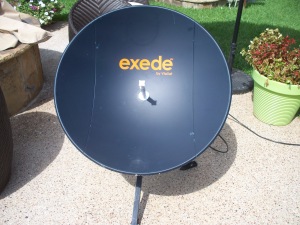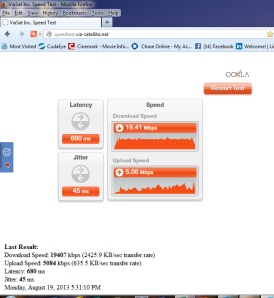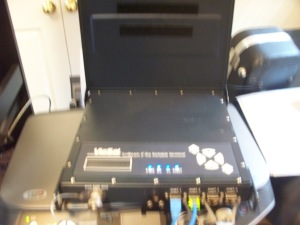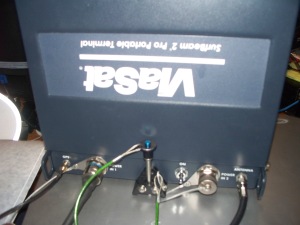ViaSat KA Band Internet Satellite – Review
Exede Portable KA Band Review: This is a small portable package that delivers big internet service from KA space segment provided by ViaSat1 satellite at 115.1W.
 The small .85M dish sets up quickly and points easily, typically in under 5 minutes. You rough it in using the angle finder gauge and then adjust with the fine screw azimuth and inclination until reaching the highest dB gain on the front panel of the Surfbeam2® Pro Portable Terminal (pictured). This is typically around 8.10 dB or greater. There’s also an audible beep that changes pitch until it reaches threshold then goes to a steady tone indicating you have reached zenith and you can hit enter and acquire network connectivity. The screen indicates a look up of GPS which is indicative of any TDMA network VSAT device and then it locks into internet. My only misgiving is that it doesn’t tell you it’s actually in network, it just stops blinking and beeping around. There are several LED’s on the front panel to tell you PWR, TX, RX and ENET indicating you have internet. The best part of the device is running a speed test once you have in online, which is surprising, because you see download speeds nearing 20MB and 5MB on upload, which is usually reserved for terrestrial cable providers but not VSAT systems on KU or C-band. There are four Ethernet metal RJ45 jacks in the front, which is right where I want them. The ergonomics were well thought out with the Ethernet router built into it, which I’m told is a Cisco OEM. There is a hinged steel lid to close and protect the LCD display and membrane soft control keys, which in my opinion could have been a little larger, my eyes and age showing here.
The small .85M dish sets up quickly and points easily, typically in under 5 minutes. You rough it in using the angle finder gauge and then adjust with the fine screw azimuth and inclination until reaching the highest dB gain on the front panel of the Surfbeam2® Pro Portable Terminal (pictured). This is typically around 8.10 dB or greater. There’s also an audible beep that changes pitch until it reaches threshold then goes to a steady tone indicating you have reached zenith and you can hit enter and acquire network connectivity. The screen indicates a look up of GPS which is indicative of any TDMA network VSAT device and then it locks into internet. My only misgiving is that it doesn’t tell you it’s actually in network, it just stops blinking and beeping around. There are several LED’s on the front panel to tell you PWR, TX, RX and ENET indicating you have internet. The best part of the device is running a speed test once you have in online, which is surprising, because you see download speeds nearing 20MB and 5MB on upload, which is usually reserved for terrestrial cable providers but not VSAT systems on KU or C-band. There are four Ethernet metal RJ45 jacks in the front, which is right where I want them. The ergonomics were well thought out with the Ethernet router built into it, which I’m told is a Cisco OEM. There is a hinged steel lid to close and protect the LCD display and membrane soft control keys, which in my opinion could have been a little larger, my eyes and age showing here.
This unit is sturdy made of Carbon Fiber on the dish which assembles easily and intuitively. The Control panel will attach to the base with one built in removable pin assembly. I opted to move it indoors after pointing. There is one coaxial cable F connector which surprise me that there’s no LNB or TX to keep straight, which was a great idea. How many have gotten these turned around or arced out an LNB? Come on fess up, you know who you are! So any way, this is a very robust military style designed hardware package, obviously intended for portable mobile deployment. There’s a pole mounted domestic version with standard set top box style modem packaged for under $1,500 I’m told. There’s a SMA connector with a 2 meter antennae lead for the GPS device which is magnetic. Oh yeah the stand is non-Ferris so it won’t stick.
I ran several speed tests, did my usual Hulu download, watched an episode of Star Trek Generations and didn’t see any obvious drop outs. I still am having a hard time justifying the data package costs, but clearly the pre-purchase plans are the way to go. If one was using this for home, you could run up quite a bandwidth bill if you weren’t careful. I believe this will be very nice for DSNG users out there wanting quick deployable IP transport. I’m told there are 3 vendors in the offering for Auto Acquisition for Drive Away and Quick deployable systems from AvL, C-Com and even Winegard. Considering the size and overall weight of this portable, which fits snuggly in an ATA style trunk, you could ESNG this around the world nicely. Portable office for Oil and Gas exploration, Geology, Disaster Recovery, or mobile office on the go, this is a nice package indeed.
We feed the Exede with a WELLAV SMP100 H.264 HD video encoder but weren’t able to connect to my colleagues streaming WOWZA server at first try. Considering the “IN routes” capacity, this is the only thing that concerns me with the DSNG application, is having enough upload bandwidth to make an adequate video encoded picture. Having said that, I have seen some remarkable 1MB uplink codecs and fly away systems recently that were very usable on the air for stand up news gathering. The global spot beams download capacity is something short of wonderful and will never leave you wanting more speed, well most people any way. It always comes down to “How good is good enough” and what it the real application. No, I’m not going to use it for multiple camera shoot on a sports or entertainment, but it could do in a pinch. Certainly video conferencing even at the Video presence level would look very nice. News gathering without excessive motion contribution is fine, and let’s face it a talking head in front of waves, fires or disaster doesn’t require that much bandwidth in reality. Obviously the Disaster Recovery market is an excellent use for this little guy and I’m told the Red Cross has already purchased 70+ units for field use. I did test my NEW Pearl 3203 IS (Intrinsically Safe) Wi-Fi “SIP/VoIP” phones across it and it was remarkably clean and low in latency for a satellite system. If one were to combine my favorite MESH/MIMNO Ruckus (5GHz /2,4GHz) Wireless outdoor access point network combined with this, would be powerful mobile communications and command center package.
KA Band, ok well everyone says, the spot beams have holes and don’t overlap. I can’t attest to this but in discussions with factory personal, I’m told the overlapping and switching is now seamless and operates much like a cell phone network. This I haven’t test and can only say, I’m happy to hear they addressed this issue and have a solution in place. If this is true, the aforementioned DSNG for the likes of storm chasers should yield some impressive footage in the days and years to come.
The other technical issue is the nasty one “Rain Fade”. This unit operates with a 4Watt BUC and I’m told they are developing an 8Watt version for future release. I haven’t had the opportunity to operate in a down poor or good ole Texas thunder storm yet as we are still having a drought here. However, the efficiency seems to be good and I would guess with the doubling the power and additional 3dB of link budget should get one through the nastiest of weather. Again, we’ll see how our storm chases fair with this last one
As always, I make no claims, these are only my subjective opinion and you are welcome to disagree with my findings base
d on your own. Always happy to share.
Michael C. Creamer
Founder Managing Partner – FAVNET LLC
For more information:
E-mail michaelc@favnet.net
Posted on August 23, 2013, in Uncategorized. Bookmark the permalink. 1 Comment.




BTW – Follow up: We tried a Adobe Flash Media Encoder in HD at 3,500Kbps and it looked and sounded great and we’re able to see the return media streamed over simple http flash media page player out with a couple of seconds delay. It looked and sounds great and was easy to set up a push player with our partners at Liquid Broadcast on their hosted Akamai servers. Shows what a good reliable internet connection can do for hosted video streaming application.